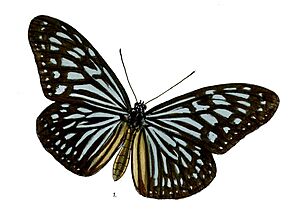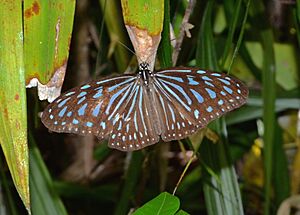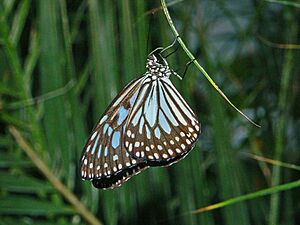Blue glassy tiger facts for kids
Quick facts for kids Blue glassy tiger |
|
|---|---|
 |
|
| Illustration of Ideopsis vulgaris | |
| Scientific classification |
The blue glassy tiger (Ideopsis vulgaris) is a beautiful butterfly. It belongs to a group of butterflies called "crows and tigers," which are part of the larger brush-footed butterflies family. These butterflies are known for their unique patterns and sometimes for being distasteful to predators.
Contents
Where They Live
Subspecies
There are different types, or subspecies, of the blue glassy tiger. Each one lives in slightly different areas:
- Ideopsis vulgaris contigua is found in places like Central Thailand, Laos, Vietnam, Hainan Island, and China.
- Ideopsis vulgaris macrina lives in Myanmar, parts of Thailand, Langkawi, Western Malaysia, Singapore, Sumatra, and other islands like Batu Islands, Banka Island, and Belitung.
Distribution
You can find the blue glassy tiger in many countries across Asia. These include India, SriLanka, Singapore, Thailand, Laos, Vietnam, Hainan, and Southern Burma. They also live in the Sundaland region, which includes Sumatra, Java, the Lesser Sunda Islands (like Alor), Borneo, and Palawan.
Habitat
These butterflies like to live in various places. They are often seen at the edges of rainforests or in plantations. You might also spot them in coastal mangrove areas, which are special forests that grow in salty water.
What They Look Like
The blue glassy tiger is a medium-sized butterfly. Its wings can spread out about 70 to 80 millimeters wide. It looks quite similar to another butterfly called the dark glassy tiger (Parantica agleoides).
One way to tell the blue glassy tiger apart is by a black bar on its front wing. This bar cuts through one of the white stripes on the wing. Like other milkweed butterflies, the blue glassy tiger is mimicked by another butterfly called Chilasa clytia (from the Papilionidae family). This means Chilasa clytia looks similar to the blue glassy tiger to trick predators into thinking it's also distasteful.
On the top side, their wings are mostly black. They have many bluish-white stripes and spots that look a bit see-through. These patterns help them blend in or warn predators.
The underside of their wings looks similar, but the patterns are often clearer. Their antennae are black. Their head and body are black with bluish-white spots.
Similar Butterflies
The blue glassy tiger can sometimes be confused with other butterflies that have similar patterns. These include:
- The blue tiger (Tirumala limniace)
- The dark glassy tiger (Parantica agleoides)
Life Cycle
Adult blue glassy tigers can be seen flying around all year long. They often visit flowers to drink nectar, which gives them energy.
The female butterflies lay white eggs that are shaped a bit like a rugby ball. These eggs usually hatch in about three days.
When the eggs hatch, tiny caterpillars emerge. At first, they are white with a black head. As they grow, they change color to a dark purplish-brown with whitish spots. A young caterpillar (called a 2nd instar) is about 7.5 to 8 millimeters long. By the time they are fully grown (the 5th and last instar), they can reach about 34 millimeters in length.
Caterpillars of the blue glassy tiger feed on specific plants. These include Gymnema species and Tylophora species, which are often found in places like mangrove areas. Because they eat these plants, the caterpillars and adult butterflies become distasteful to birds and other predators. This is a natural defense mechanism.
After the caterpillar is fully grown, it turns into a pupa. The pupa is bright yellowish-green and about 18 to 20 millimeters long. After about seven days, the beautiful blue glassy tiger butterfly emerges from the pupa, ready to fly!
See also
- List of butterflies of India (Danainae)



